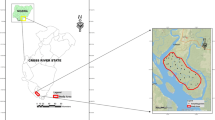Abstract
Development of a method to assess and monitor soil quality is critical to soil resource management and policy formation. To be useful, a method for assessing soil quality must be able to integrate many different kinds of data, allow evaluation of soil quality based on alternative uses or definitions and estimate soil quality for unsampled locations. In the present study we used one such method, based on non-parametric geostatistics. We evaluated soil quality from the integration of six soil variables measured at 220 locations in an agricultural field in southeastern Washington State. We converted the continous data values for each soil variable at each location to a binary variable indicator transform based on thresholds. We then combined indicator transformed data for individual soil variables into a single integrative indicator of soil quality termed a multiple variable indicator transform (MVIT). We observed that soil chemical variables, pools of soil resources, populations of microorgansims, and soil enzymes covaried spatially across the landscape. These ensembles of soil variables were not randomly distributed, but rather were systematically patterned. Soil quality maps calculated by kriging showed that the joint probabilities of meeting specific MVIT selection were influenced by the critical threshold values used to transform each individual soil quality variable and the MVIT selection criteria. If MVIT criteria adequately reflect soil quality then the kriging can produce maps of the probabilty of a soil being of good or poor quality.
Similar content being viewed by others
References
Allison FE (1973) Soil organic matter and its role in crop production. Developments in Soil Science 3, Elsevier, New York
Anderson JPE, Domsch KH (1978) A physiological method for the quantitative mesaurement of microbial biomass in soils. Soil Biol Biochem 10:215–221
Bolton H Jr, Elliott LF, Papendick RI, Bezdicek DF (1985) Soil microbial biomass and selected soil enzyme activities: effect of fertilization and cropping practices. Soil Biol Biochem 17:297–302
Doran JW, Parkin TB (1994) Defining and assessing soil quality. In: Doran JW, Coleman DC, Dezdicek DF, Stewart BA (eds) Defining soil quality for a sustainable environment. Soil Sci Soc Am, Spec Publ, Madison, Wis, pp 3–21
Dunnewald TJ (1917) Vegetation on swamps and marshes as an indicator of the quality of peat soil for cultivation. Agron J 9:322–324
Gale MR, Grigal DF, Harding RB (1991) Soil productivity index: predictions of site quality for white spruce plantations. Soil Sci Soc Am J 55:1701–1708
Granatstein D, Bezdicek DF (1992) The need for a soil quality index: local and regional perspectives. Am J Alternative Agric 7:12–16
Haberern J (1992) A soil health index. J Soil Water Sci 47:6
Hilgard EW (1914) Soils, their formation, properties, composition, and relations to climate and plant growth in the humid and arid regions. Macmillan, New York
Isaaks EH, Srivastava RM (1989) An introduction to applied geostatistics. Oxford University Press, New York
Journel AG (1983) Non-parametric estimation of spatial distributions. Math Geol 15:445–468
Journel AG (1988) Non-parametric geostatistics for risk and additional sampling assessment. In: Keith L (ed) Principles of environmental sampling. Am Chem Soc Washington, DC, pp 45–72
Journel AG, Huijbregts CJ (1978) Mining geostatistics. Academic Press, London
National Research Council (1993) Soil and water quality: An agenda for agriculture. Committee on Long-Range Soil and Water Conservation, Board of Agriculture, National Academy Press, Washington, DC
Parr JF, Papendick RI, Hornick SB, Meyer RE (1992) Soil quality: Attributes and relationship to alternative and sustainable agriculture, Am J Alternative Agric 7:5–11
Rodale Institute (1991) International conference on the assessment and monitoring of soil quality. Rodale Institute, Emmaus, Pa
Rossi RE, Mulla DJ, Journel AG, Franz EH (1992) Geostatistical tools for modeling and interpreting ecological spatial independence. Ecol Monogr 62:277–314
Roosi RE, Borth PW, Tollefson JJ (1993) Stochastic simulation for characterizing ecological spatial patterns and appraising risk. Ecol Appl 3:719–735
Singh KK, Colvin TS, Erbach DC, Mughal AQ (1992) Tilth index: An approach to quantifying tilth. Trans ASAE 35:1777–1785
Smith JL, Halvorson JJ, Papendick RI (1993) Using multiple-varible indicator kriging for evaluating soil quality. Soil Sci Soc Am J 57:743–749
Sparling GP (1992) Ratio of microbial biomass carbon to soil organic carbon as a sensitive indicator of changes in soil organic matter. Aust J Soil Res 30:195–207
Storie ER (1976) Storie index rating. Spec Publ 3203, Appendix D, Div Agric Sci, Univ Calif, Berkeley
Srivastava RM, Parker HM (1989) Robust measure of spatial continuity. In: Armstrong M (ed) Geostatistics, vol 1. Kluwer Academic, Dordrecht, pp 295–308
Wischmeier WH, Smith DD (1965) Predicting rainfall-erosion losses from cropland east of the Rocky Mountains. Agric Handb 282, US Dep Agric, Washington, DC
Yamakura T, Sahunalu P (1990) Soil carbon/nitrogen ratio as a site quality index for south-east asian forests. J Trop Ecol 6: 371–377
Author information
Authors and Affiliations
Rights and permissions
About this article
Cite this article
Halvorson, J.J., Smith, J.L. & Papendick, R.I. Integration of multiple soil parameters to evaluate soil quality: a field example. Biol Fertil Soils 21, 207–214 (1996). https://doi.org/10.1007/BF00335937
Received:
Issue Date:
DOI: https://doi.org/10.1007/BF00335937




